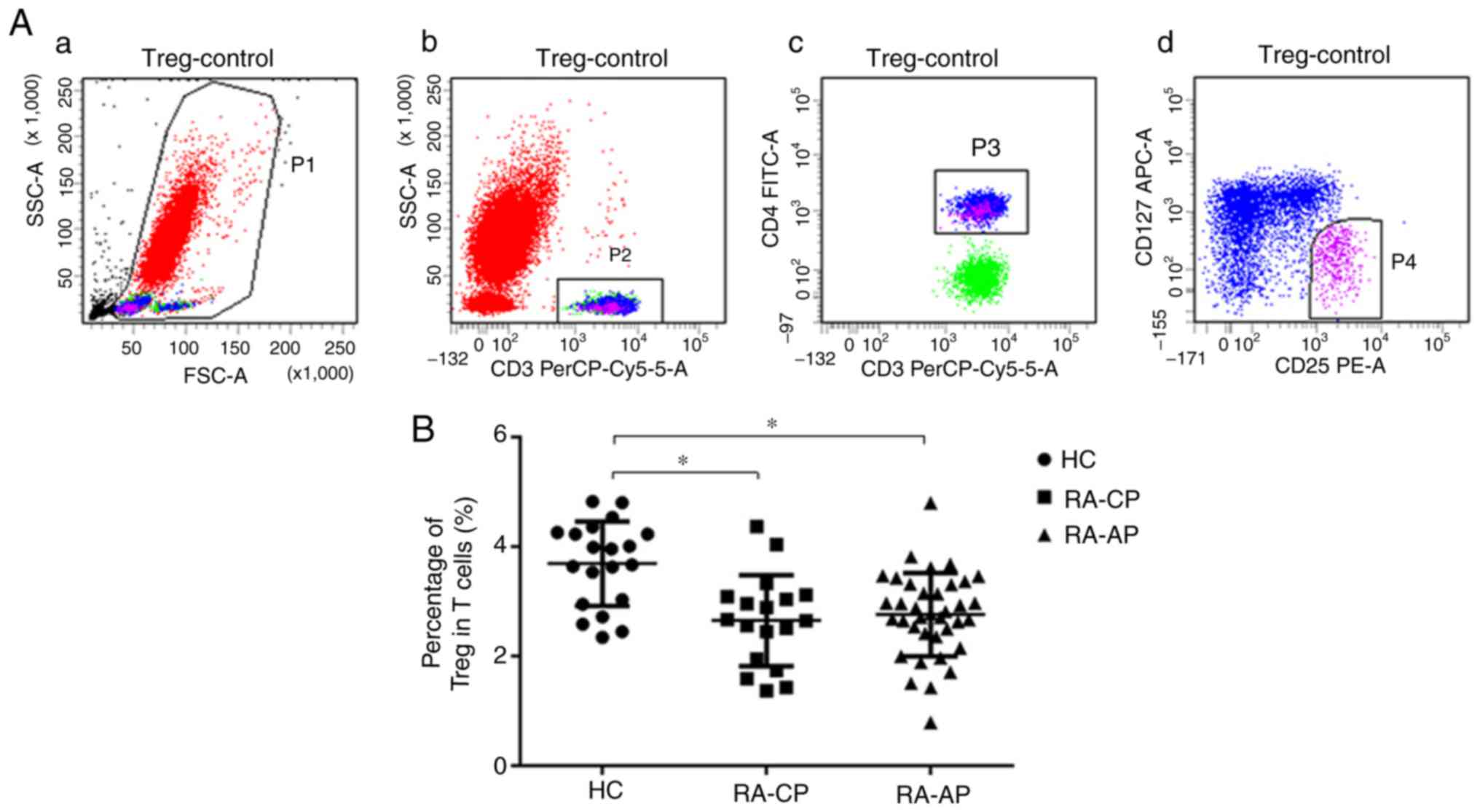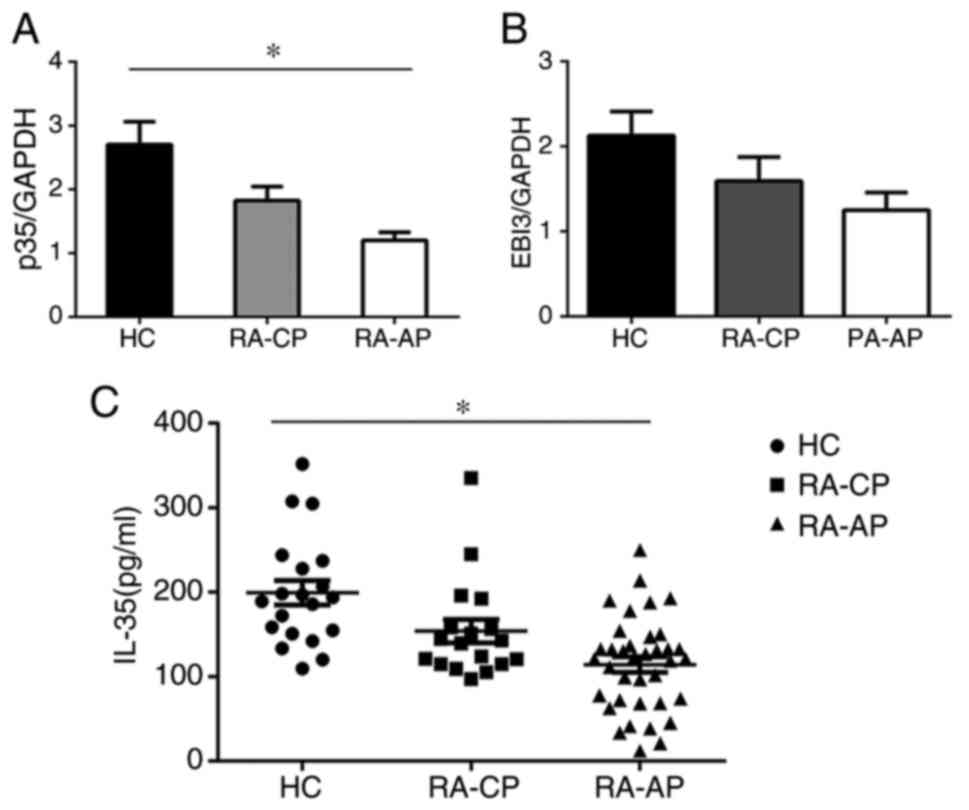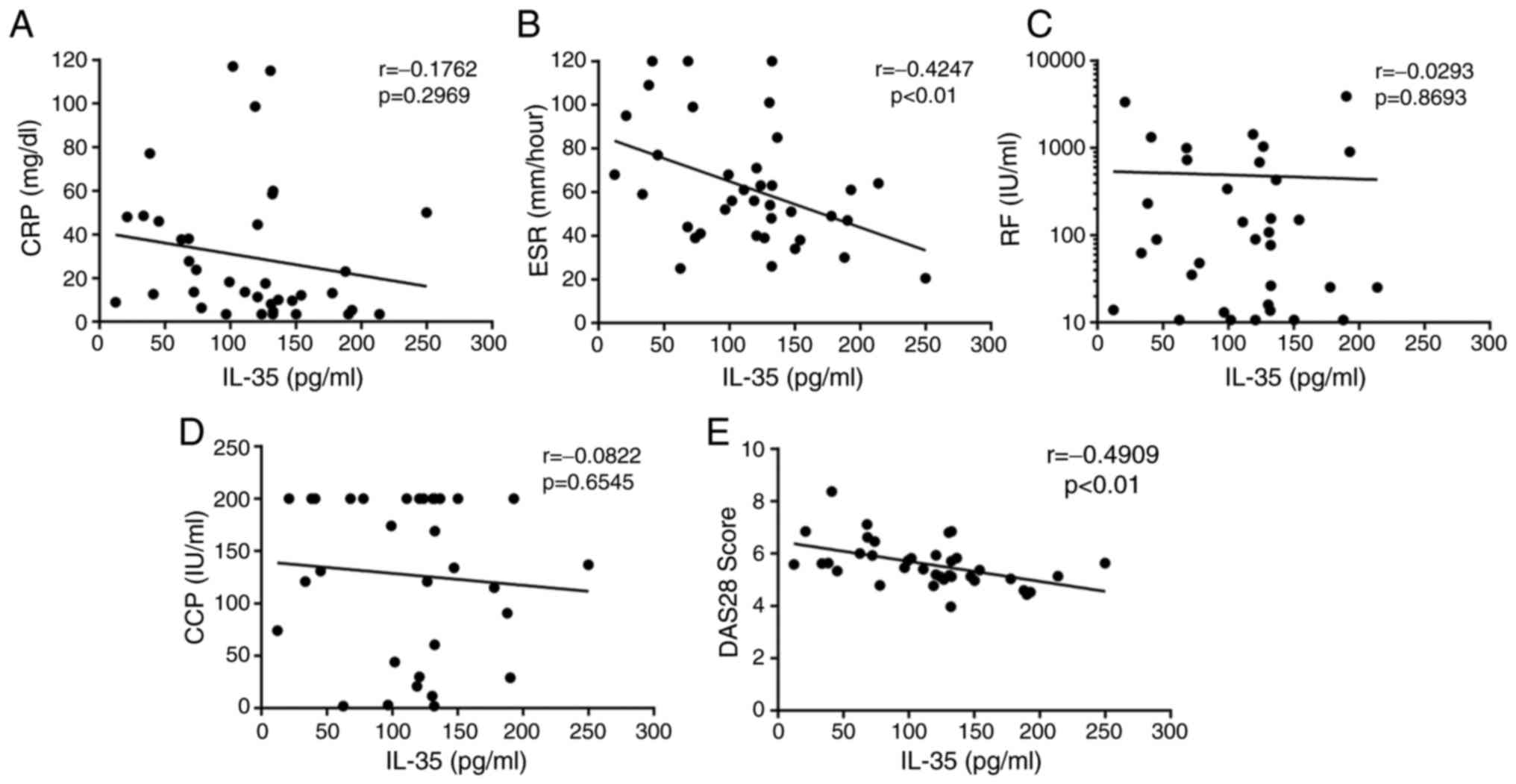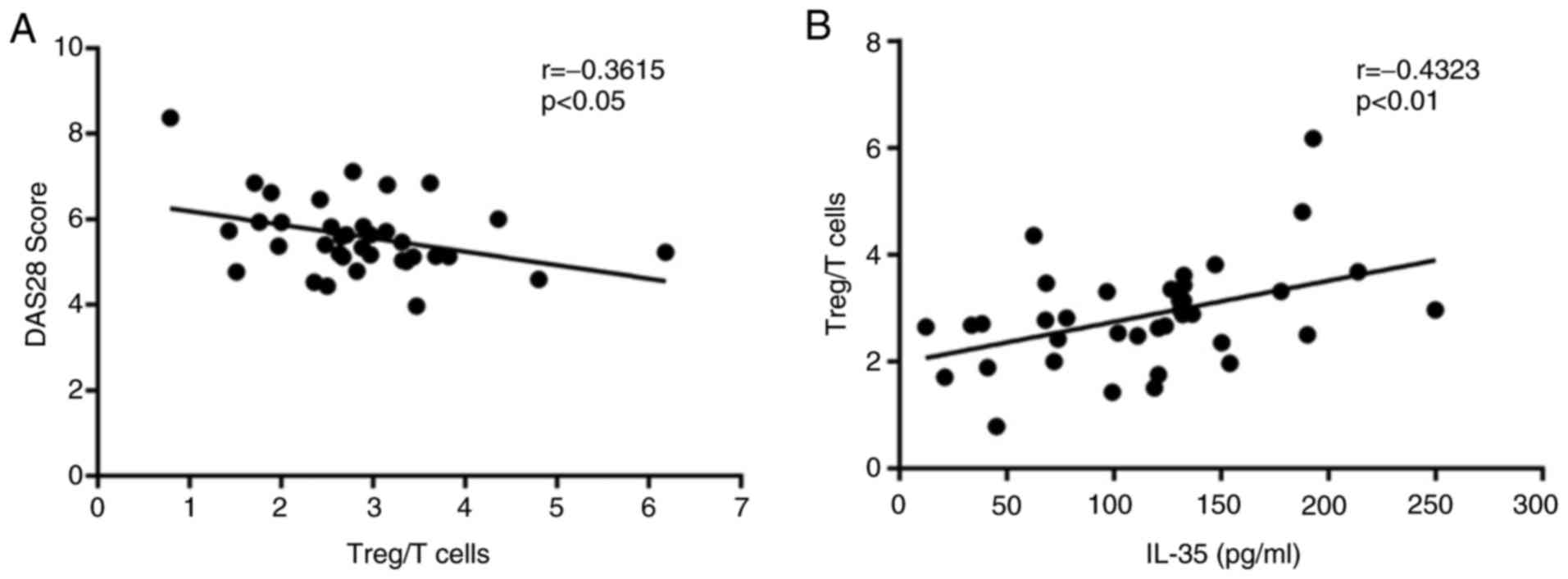|
1
|
McInnes IB and Schett G: The pathogenesis
of rheumatoid arthritis. N Engl J Med. 365:2205–2219. 2011.
View Article : Google Scholar : PubMed/NCBI
|
|
2
|
Wing K and Sakaguchi S: Regulatory T cells
exert checks and balances on self tolerance and autoimmunity. Nat
Immunol. 11:7–13. 2010. View
Article : Google Scholar : PubMed/NCBI
|
|
3
|
Zhang H, Guo H, Lu L, Zahorchak AF,
Wiseman RW, Raimondi G, Cooper DK, Ezzelarab MB and Thomson AW:
Sequential monitoring and stability of ex vivo expanded autologous
and nonautologous regulatory T cells following infusion in nonhuman
primates. Am J Transplant. 15:1253–1266. 2015. View Article : Google Scholar : PubMed/NCBI
|
|
4
|
Morgan ME, Flierman R, van Duivenvoorde
LM, Witteveen HJ, van Ewijk W, van Laar JM, de Vries RR and Toes
RE: Effective treatment of collagen induced arthritis by adoptive
transfer of CD25+ regulatory T cells. Arthritis Rheum.
52:2212–2221. 2005. View Article : Google Scholar : PubMed/NCBI
|
|
5
|
Nguyen LT, Jacobs J, Mathis D and Benoist
C: Where FoxP3-dependent regulatory T cells impinge on the
development of inflammatory arthritis. Arthritis Rheum. 56:509–520.
2007. View Article : Google Scholar : PubMed/NCBI
|
|
6
|
Alunno A, Manetti M, Caterbi S,
Ibba-Manneschi L, Bistoni O, Bartoloni E, Valentini V, Terenzi R
and Gerli R: Altered immunoregulation in rheumatoid arthritis: The
role of regulatory T cells and proinflammatory Th17 cells and
therapeutic implications. Mediators Inflamm. 2015:7517932015.
View Article : Google Scholar : PubMed/NCBI
|
|
7
|
Jiao Z, Wang W, Jia R, Li J, You H, Chen L
and Wang Y: Accumulation of FoxP3 expressing CD4+CD25+ T cells with
distinct chemokine receptors in synovial fluid of patients with
active rheumatoid arthritis. Scand J Rheumatol. 36:428–433. 2007.
View Article : Google Scholar : PubMed/NCBI
|
|
8
|
Möttönen M, Heikkinen J, Mustonen L,
Isomäki P, Luukkainen R and Lassila O: CD4+ CD25+ T cells with the
phenotypic and functional characteristics of regulatory T cells are
enriched in the synovial fluid of patients with rheumatoid
arthritis. Clin Exp Immunol. 140:360–367. 2005. View Article : Google Scholar : PubMed/NCBI
|
|
9
|
Han GM, O'Neil-Andersen NJ, Zurier RB and
Lawrence DA: CD4+CD25high T cell numbers are enriched in the
peripheral blood of patients with rheumatoid arthritis. Cell
Immunol. 253:92–101. 2008. View Article : Google Scholar : PubMed/NCBI
|
|
10
|
Sansom DM and Walker LS: The role of CD28
and cytotoxic T-lymphocyte antigen-4 (CTLA-4) in regulatory T-cell
biology. Immunol Rev. 212:131–148. 2006. View Article : Google Scholar : PubMed/NCBI
|
|
11
|
Okamura T, Fujio K, Sumitomo S and
Yamamoto K: Roles of LAG3 and EGR2 in regulatory T cells. Ann Rheum
Dis. 2 Suppl 71:i96–i100. 2012. View Article : Google Scholar
|
|
12
|
Collison LW, Workman CJ, Kuo TT, Boyd K,
Wang Y, Vignali KM, Cross R, Sehy D, Blumberg RS and Vignali DA:
The inhibitory cytokine IL-35 contributes to regulatory T-cell
function. Nature. 450:566–569. 2007. View Article : Google Scholar : PubMed/NCBI
|
|
13
|
Wang RX, Yu CR, Dambuza IM, Mahdi RM,
Dolinska MB, Sergeev YV, Wingfield PT, Kim SH and Egwuagu CE:
Interleukin-35 induces regulatory B cells that suppress autoimmune
disease. Nat Med. 20:633–641. 2014. View
Article : Google Scholar : PubMed/NCBI
|
|
14
|
Shen P, Roch T, Lampropoulou V, O'Connor
RA, Stervbo U, Hilgenberg E, Ries S, Dang VD, Jaimes Y, Daridon C,
et al: IL-35-producing B cells are critical regulators of immunity
during autoimmune and infectious diseases. Nature. 507:366–370.
2014. View Article : Google Scholar : PubMed/NCBI
|
|
15
|
Collison LW, Chaturvedi V, Henderson AL,
Giacomin PR, Guy C, Bankoti J, Finkelstein D, Forbes K, Workman CJ,
Brown SA, et al: IL-35-mediated induction of a potent regulatory T
cell population. Nat Immunol. 11:1093–1101. 2010. View Article : Google Scholar : PubMed/NCBI
|
|
16
|
Niedbala W, Wei XQ, Cai B, Hueber AJ,
Leung BP, McInnes IB and Liew FY: IL-35 is a novel cytokine with
therapeutic effects against collagen-induced arthritis through the
expansion of regulatory T cells and suppression of Th17 cells. Eur
J Immunol. 37:3021–3029. 2007. View Article : Google Scholar : PubMed/NCBI
|
|
17
|
Kochetkova I, Golden S, Holderness K,
Callis G and Pascual DW: IL-35 stimulation of CD39+ regulatory T
cells confers protection against collagen II-induced arthritis via
the production of IL-10. J Immunol. 184:7144–7153. 2010. View Article : Google Scholar : PubMed/NCBI
|
|
18
|
Ning X, Jian Z and Wang W: Low serum
levels of interleukin 35 in patients with rheumatoid arthritis.
Tohoku J Exp Med. 237:77–82. 2015. View Article : Google Scholar : PubMed/NCBI
|
|
19
|
Nakano S, Morimoto S, Suzuki S, Tsushima
H, Yamanaka K, Sekigawa I and Takasaki Y: Immunoregulatory role of
IL-35 in T cells of patients with rheumatoid arthritis.
Rheumatology (Oxford). 54:1498–1506. 2015. View Article : Google Scholar : PubMed/NCBI
|
|
20
|
Arnett FC, Edworthy SM, Bloch DA, McShane
DJ, Fries JF, Cooper NS, Healey LA, Kaplan SR, Liang MH and Luthra
HS: The american rheumatism association 1987 revised criteria for
the classification of rheumatoid arthritis. Arthritis Rheum.
31:315–324. 1988. View Article : Google Scholar : PubMed/NCBI
|
|
21
|
Prevoo ML, van'tHof MA, Kuper HH, van
Leewen MA, van de Putte LB and van Riel PL: Modified disease
activity scores that include twenty-eight-joint counts. Development
and validation in a prospective longitudinal study of patients with
rheumatoid arthritis. Arthritis Rheum. 38:44–48. 1995. View Article : Google Scholar : PubMed/NCBI
|
|
22
|
Livak KJ and Schmittgen TD: Analysis of
relative gene expression data using real-time quantitative PCR and
the 2(-Delta Delta C(T)) method. Methods. 25:402–408. 2001.
View Article : Google Scholar : PubMed/NCBI
|
|
23
|
Hartigan-O'Connor DJ, Poon C, Sinclair E
and McCune JM: Human CD4+ regulatory T cells express lower levels
of the IL-7 receptor α chain (CD127), allowing consistent
identification and sorting of live cells. J Immunol Methods.
319:41–52. 2007. View Article : Google Scholar : PubMed/NCBI
|
|
24
|
Kawashiri SY, Kawakami A, Okada A, Koga T,
Tamai M, Yamasaki S, Nakamura H, Origuchi T, Ida H and Eguchi K:
CD4+CD25(high)CD127(low/-) Treg cell frequency from peripheral
blood correlates with disease activity in patients with rheumatoid
arthritis. J Rheumatol. 38:2517–2521. 2011. View Article : Google Scholar : PubMed/NCBI
|
|
25
|
Moradi B, Schnatzer P, Hagmann S, Rosshirt
N, Gotterbarm T, Kretzer JP, Thomsen M, Lorenz HM, Zeifang F and
Tretter T: CD4+CD25+/highCD127low/- regulatory T cells are enriched
in rheumatoid arthritis and osteoarthritis joints-analysis of
frequency and phenotype in synovial membrane, synovial fluid and
peripheral blood. Arthritis Res Ther. 16:R972014. View Article : Google Scholar : PubMed/NCBI
|
|
26
|
Haque R, Lei F, Xiong X, Bian Y, Zhao B,
Wu Y and Song J: Programming of regulatory T cells from pluripotent
stem cells and prevention of autoimmunity. J Immunol.
189:1228–1236. 2012. View Article : Google Scholar : PubMed/NCBI
|
|
27
|
Wright GP, Notley CA, Xue SA, Bendle GM,
Holler A, Schumacher TN, Ehrenstein MR and Stauss HJ: Adoptive
therapy with redirected primary regulatory T cells results in
antigen-specific suppression of arthritis. Proc Natl Acad Sci USA.
106:19078–19083. 2009. View Article : Google Scholar : PubMed/NCBI
|
|
28
|
Pope RM and Shahrara S: Possible roles of
IL-12-family cytokines in rheumatoid arthritis. Nat Rev Rheumatol.
9:252–256. 2013. View Article : Google Scholar : PubMed/NCBI
|
|
29
|
Thiolat A, Denys A, Petit M, Biton J,
Lemeiter D, Herve R, Lutomski D, Boissier MC and Bessis N:
Interleukin-35 gene therapy exacerbates experimental rheumatoid
arthritis in mice. Cytokine. 69:87–93. 2014. View Article : Google Scholar : PubMed/NCBI
|
|
30
|
Ouyang H, Shi YB, Liu ZC, Wang Z, Feng S,
Kong SM and Lu Y: Decreased interleukin 35 and CD4+EBI3+ T cells in
patients with active systemic lupus erythematosus. Am J Med Sci.
348:156–161. 2014. View Article : Google Scholar : PubMed/NCBI
|
|
31
|
Jafarzadeh A, Jamali M, Mahdavi R,
Ebrahimi HA, Hajghani H, Khosravimashizi A, Nemati M, Najafipour H,
Sheikhi A, Mohammadi MM and Daneshvar H: Circulating levels of
interleukin-35 in patients with multiple sclerosis: Evaluation of
the influences of FOXP3 gene polymorphism and treatment program. J
Mol Neurosci. 55:891–897. 2015. View Article : Google Scholar : PubMed/NCBI
|
|
32
|
Tao L, Zhu J, Chen Y, Wang Q, Pan Y, Yu Q,
Zhou B and Zhu H: IL-35 improves Treg-mediated immune suppression
in atherosclerotic mice. Exp Ther Med. 12:2469–2476. 2016.
View Article : Google Scholar : PubMed/NCBI
|
|
33
|
Zongyi Y, Funian Z, Hao L, Xin W, Ying C,
Jialin Z, Yongfeng L and Baifeng L: Interleukin-35 mitigates the
function of murine transplanted islet cells via regulation of
Treg/Th17 ratio. PLoS One. 12:e01896172017. View Article : Google Scholar : PubMed/NCBI
|


















